#mycenaean
Text
TERFs die mad: you just reblogged a nasty transgender person with pronouns and all who did this historical look to explore their cultural history as well as express their own nonbinary identity in a way that resonates with them. An edit I wish I didn’t have to make on this post
I’ll try to post the actual pictures I took soon, but I was bored today and wanted to shirk some other responsibilities, so I decided to do some general vague Minoan or Mycenaean look since it’s been on the mind and also my hair was looking really good today and I wanted to take advantage of that haha
#Disclaimer: I haven’t made myself any actual historical gear yet this is all just random shit from my closet#historical fashion#minoan#mycenaean#ancient greece#How do I categorize this on my blog lol#I guess it’s. Technically? Cosplay? As cosplay is costume play uhhhh#I’ll just put it in that tag#my cosplay
2K notes
·
View notes
Text



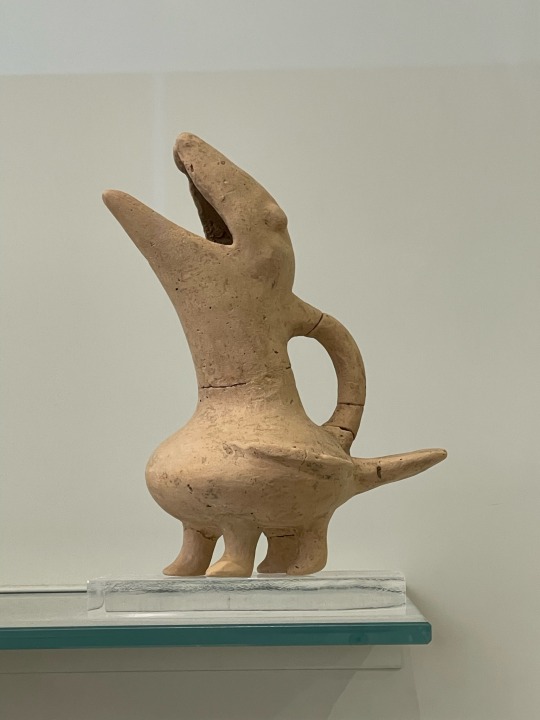
I had the immense privilege of going to Greece earlier this summer. I took 400 pictures of ancient pottery and came home inspired to put octopodes on everything.
1. My octopodes on some tiny vases and a cup
2. My reference photo of a Mycenean amphora with an octopus in the Minoan Marine Style, 1500s BCE. (National Arcaelogical Museum, Athens)
3. My bird jug with printed reference photo
4. Bird-shaped vessel from Crete, 2700 - 1900 BCE (Heraklion Archaelogical Museum, Heraklion)
2K notes
·
View notes
Text

i don’t know why odysseus was so scared of a bunch of women, what an incel (circes island)
#calculating how much a post is going to bomb on the “effort put in” to “attention gained” inverse ratio#no but genuinley i love my art rn i’m in my moment#ancient greek#greek mythology#minoan#mycenaean#digital art#digital painting#circe#epic the circe saga#circes island#fanart#tsoa#odessey
756 notes
·
View notes
Text

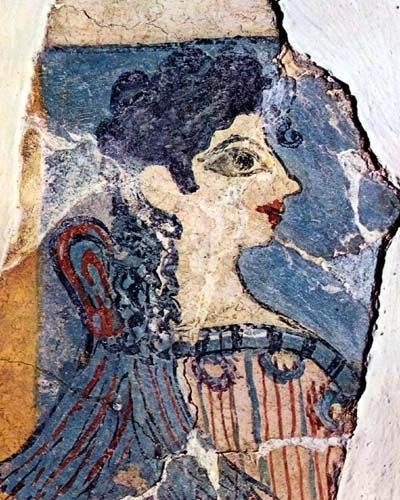
Sketchbook - Minoan and Mycenaean Art serie
758 notes
·
View notes
Text

The Odyssey (Wine Dark Sea) 2023
Another Illustration to the epics of Homer
#odyssey#homer#the iliad#ancient greek mythology#ancientgreece#mycenaean greece#mycenaean#marysmirages#bronze age#art#shep#cloud#sea
849 notes
·
View notes
Text

The Tomb of Agamemnon by Louis Jean Desprez
#agamemnon#tomb#art#louis jean desprez#greek mythology#mycenae#mycenaean#king#architecture#funeral#ancient greece#ancient greek#history#antiquity#classical antiquity#europe#european#greek#greece#mythology#ancient#ancient world#funerals
549 notes
·
View notes
Text
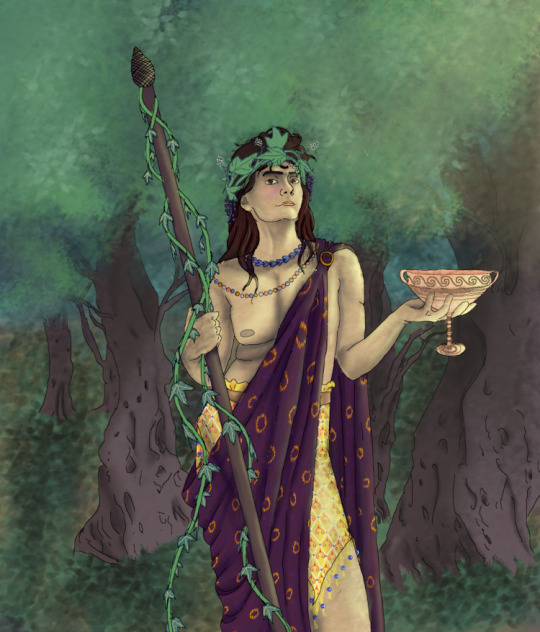
A Mycenaean inspired Dionysus. The kilt is inspired from the Processional Fresco at Knossos, with a stylised ivy leaf design. The original kilt with this pattern is blue, but yellow seemed more appropriate here. The necklace of blue beads is also the Mycenaean stylised ivy leaf, based on archaeological finds. The way the two necklaces are inspired by the Knossian 'Priest King/Prince of the Lilies'. He wears a crown of vine leaves and flowers. The cloak was because I felt that a purple would contrast better than a leopard skin (which would add more tawny colours). I've taken inspiration from the leopard with the golden rosettes, contrasting against a wine-dark fabric.
238 notes
·
View notes
Text
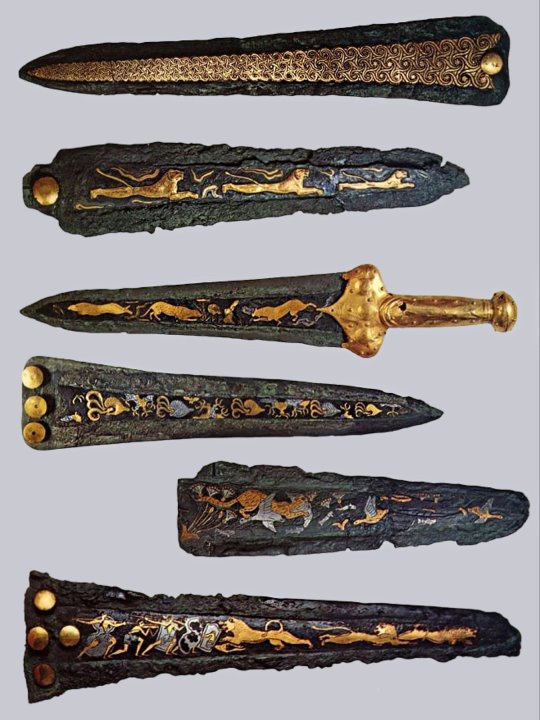
Mycenaean Swords with elaborate 'Gold Plating' (1600-1300 BC), Crete, Greece.
Sword with gold-capped rivet and gold plating on the hilt.
Small dagger with three gold-plated rivets.
Gold-plated hilt with repoussé decoration representing lions hunting goats, held in place by gold rivets and gold ring.
Sword with repoussé spiral motif on hilt.
Sword with five gold-plated rivets.
Courtesy: Archaeological Museum of Heracleion, Crete
#art#history#design#style#archeology#sculpture#crete greece#sword#dagger#gold -plated#mycenaean#1600BC#1300BC
242 notes
·
View notes
Text
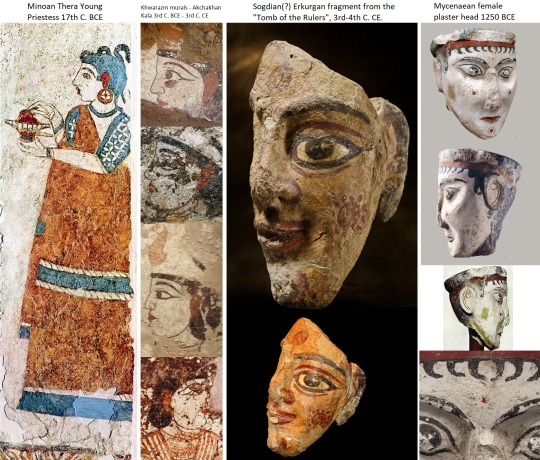
Comparison of Minoan, Mycenaean, Sogdian, & Khwarazm artworks 17th C. BCE - 4th C. CE
When I came across the Khwarazm (aka Chorasmian) murals I remembered this red-eared priestess from Thera. Their large eyebrows, red-painted ears, extremely light skin tone, and general facial features look very similar to each other despite being over 1,000 years apart and in different regions of the world. Other than that their clothing, jewelry, and hairstyle are quite different. I couldn't figure out what the significance of the red ears were, though Jason Earle speculates it might be an artistic depiction of a person hearing something divine from a deity (Cosmetics and Cult Practices in the Bronze Age Aegean? A Case Study of Women with Red Ears). These are the only images I've come across, that I can recall, of people with their ears painted red so I felt like comparing them.
The Erkurgan fragment has red solar symbols very similar to the Mycenaean plaster head. Again these two pieces of art are over 1,000 years apart and in different geographic locations. I don't know who the Erkurgan fragment should be attributed to, but this was a place in the heart of Sogdiana. I assume it represents a Sogdian because of location and time period, but that's just my assumption. Solar symbols appear in basically all civilizations, but I've never come across these specific red styled ones (that I can recall) except in these two instances. In both instances they appear on the cheeks, forehead, and probably the chin (the Erkurgan fragment's chin is damaged but seems to have some red paint). Again, seeing this unique symbol made me feel I should compare the two. From what I've read all the images here are generally thought to be depictions of females with religious significance.
#minoan#mycenaean#art history#ancient history#ancient#art#antiquities#history#paganism#pagan#goddess#priestess#indo european#ancient art#archaeology#anthropology#sogdiana#ancient greece
272 notes
·
View notes
Text

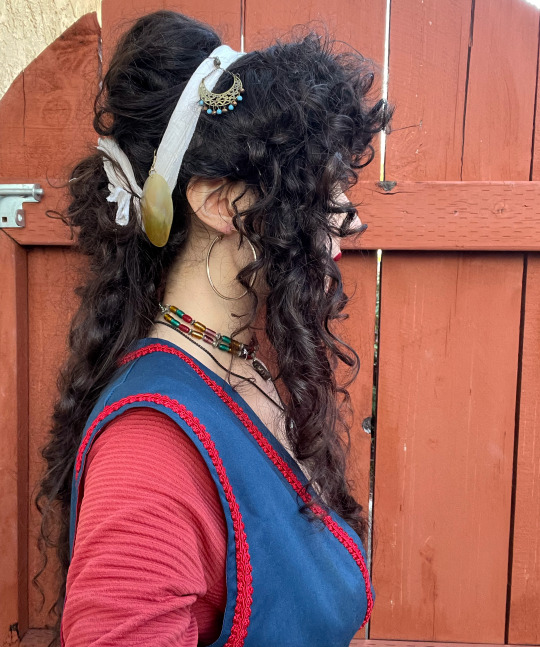


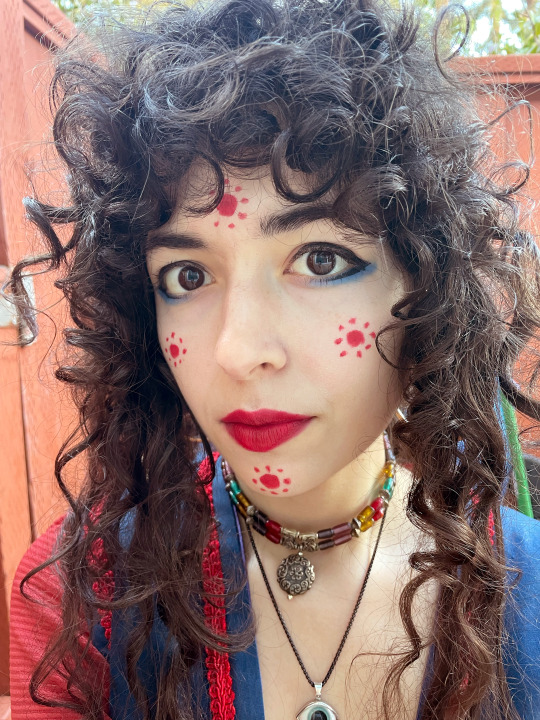

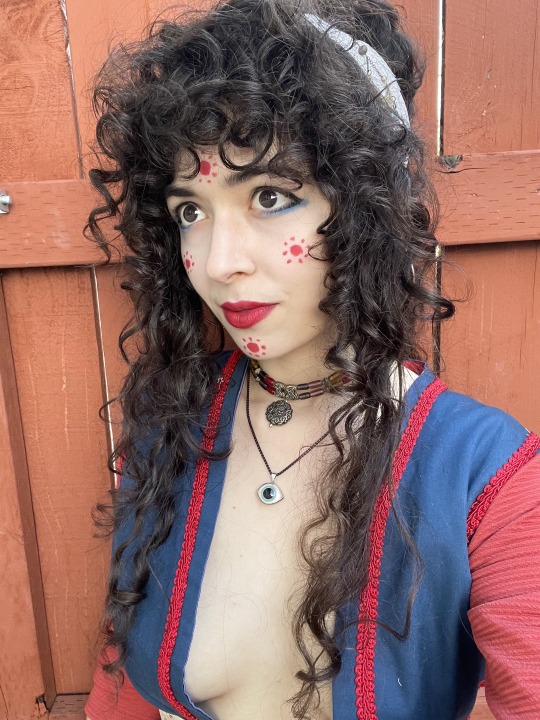
Here are some of the pictures of the Minoan/Mycenaean look I did yesterday! Mind you, it's all very generalized since I haven't made any clothing studies from these time periods yet, so I had just grabbed random clothes and jewelry from my closet that I could at least pass off as the ~vibe~ . I went for a pretty simple interpretation of makeup back then and ended up not really putting a whole lot on my face before the decorative elements, just a very thin amount of white foundation, but even so I figured my skin is pretty pale as it is that if this were historical I probably would have just been fairly bare faced anyway in a similar fashion. I tried to stay pretty close to how makeup might be applied back then and not go too anachronistic, and if I did it was for photographic or artistic purposes (namely, light contouring on my nose not for any sort of like, modern feature minimization, but to make sure my own Greek ethnic features weren't flattened by lighting levels or camera perspective)
Overall this was a really fun exploration of historic culture! Seeing the finished makeup on myself kind of brought over this cultural euphoria for me, even though many things have changed since ancient Mediterranean civilizations, there's almost a feeling of sameness in exploring the history of your heritage and seeing someone who looks or feels like you in ancient art. (But also a brief little disclaimer: the Mediterranean has been an extremely diverse region for thousands of years! I'm just one way of looking and that absolutely isn't representative of all people of Greece, neither then nor now!) I want to explore more historical fashions within this realm, and next time try a more extreme version of the makeup, something that feels more on the ceremonial side than casual like this one.
#wahoo! yippee!!! anywho enjoy and sorry i rambled a lot in the post im not good at being a brief person lol#historical fashion#ancient greece#minoan#mycenaean#greece#greek#history#antiquity#ancient greek#my cosplay
181 notes
·
View notes
Text

An Ariadne and Dionysus sketch I‘m not particularly pleased with
#my art#dionysos#dionysus#ariadne#greek mythology#hellenic polytheism#classical studies#mycenaean#minoan crete#bacchus#the sketches i dislike are always the ones to blow up#i swear if this recieves the same treatment-
390 notes
·
View notes
Text
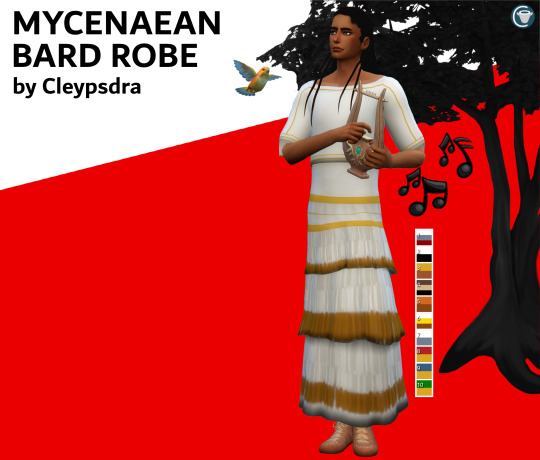
Mycenaean Bard Robe
A layered gown for your Mycenaean bard or priest.
Robe/Long Dress category
10 swatches
Base game compatible
Adult male
ROBE DOWNLOAD - Dropbox (no ads)
#MY CC#my cas cc#S4CC#TS4CC#SIMS 4#SIMS 4 CC#mycenaean#TS4MM#GREEK#GREECE#BRONZE AGE#TS4 HISTORY#TS4 HISTORY CC#TS4 HISTORIC#TS4 HISTORIC CC#TS4 CAS#TS4 MMCC#TS4 MALE CC#TS4#SIMS#S4MM#MAXIS MATCH CC#TS4 HISTORICAL#S4 HISTORY#S4 HISTORICAL#BASE GAME COMPATIBLE#mycenae#pylos#palace of nestor#nestor
124 notes
·
View notes
Text
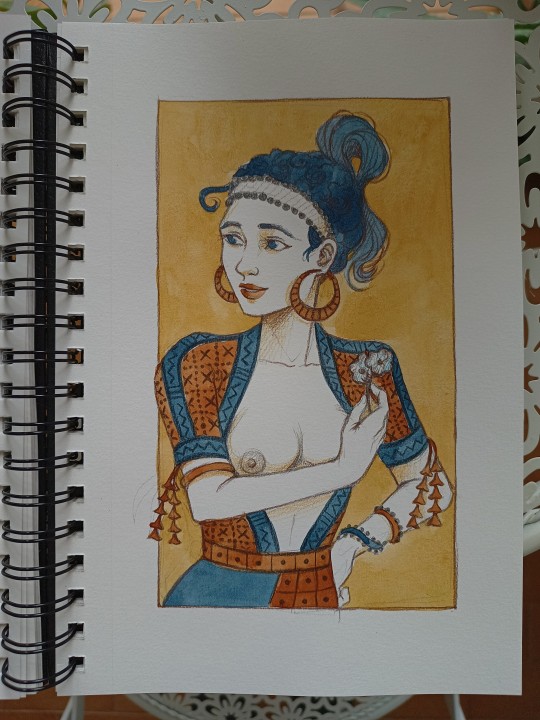

Sketchbook - Minoan and Mycenaean Art serie
582 notes
·
View notes
Text

The Odyssey. Wine Dark Sea (gouache version) (2023)
Another version of the Illustration to the epics of Homer
#marysmirages#ancient greek mythology#mycenaean greece#bronze age#iliad#painting#odyssey#sea landscape#cloud#moon#homer#artist#ancient greece#mycenaean
689 notes
·
View notes
Text
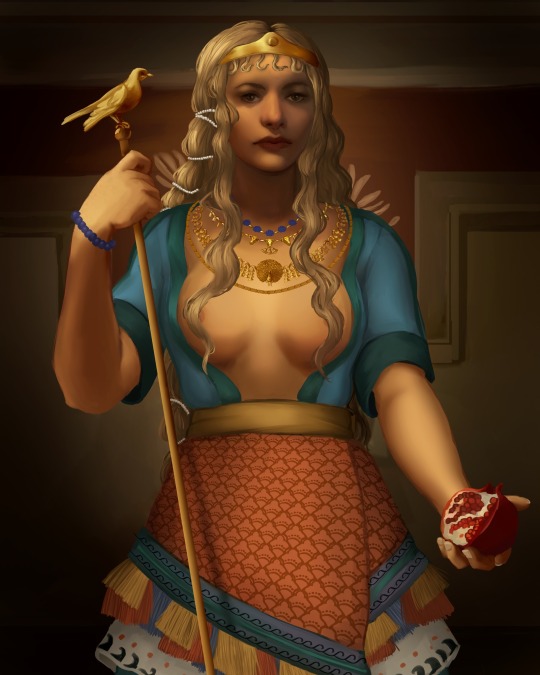
Mycenaean Hera 🦚 commission for @blantheia
728 notes
·
View notes
Text
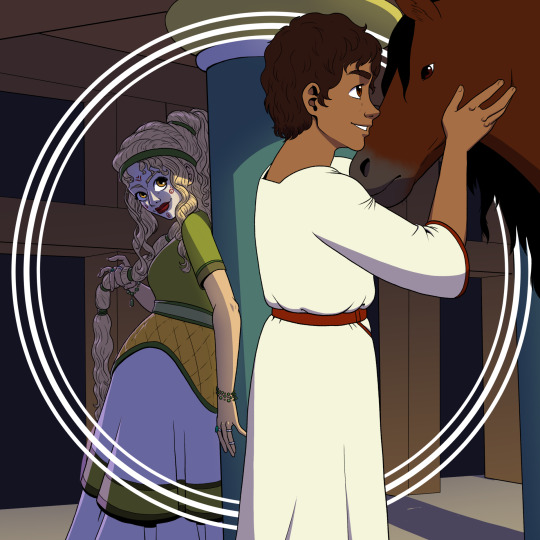
Classicstober Day 18: Phaedra (𐀙𐀂𐀉𐀨)
Phaedra was Ariadne's sister and married Theseus to become Queen of Athens (that must have been a WILD Christmas dinner). Things were good until Theseus' son by the Amazon queen dropped by for a visit. His name was Hippolytus (𐀂𐀢𐀬𐀵)…
Phaedra's story isn't quite as well known as many others in greek mythology, outside of a few tragedies and operas. The nature of the beast for most of these stories is that there are a couple of versions and no one can say which one is the 'real' one, but Phaedra's story, depending on the version you go by, can have wildly different vibes.
As I mentioned, she was Ariadne's sister. In some versions, when Ariadne helped Theseus defeat the Minotaur and escape, Phaedra was with her and part of Theseus' crew when he decided to abandon Ariadne on Naxos, eventually becoming his wife in Athens. In others, Phaedra is ignorant of the role Ariadne played in Theseus' victory and is instead sent to Athens to marry him for a political alliance. The implications of both versions are fascinating from a story-telling perspective. If Phaedra left with Theseus, just how complicit was she in leaving Ariadne behind? If their marriage was purely political, what did she think of the man who had just abandoned her sister? In the end, though, the important part (story wise) is that she marries Theseus and becomes Queen of Athens.
I depicted Phaedra here in her full queenly raiment. Yes, Athens was a purely Mycenaean settlement at this time, but the Mycenaean woman's fashion borrowed LOTS from the Minoan and considering where Phaedra was born she deserved a more Minoan look. That's why she has that quilted-looking over-garment on her dress. I made her palette green to represent her role as queen of Athens, and since Athena is the goddess of olive trees it made sense to me to lean into it. She is also blonde and amber-eyed to show her connection to Helios through her mother, Pasiphaë.
The architecture here is based on Minoan buildings. I imagine that inside the Cyclopean walls of Mycenaean Athens they could afford to make things more royal and less military-pragmatism. Athens is known for being a center of intellectualism in the ancient world (an image they painted themselves with), but even though this scene is set many centuries before the height of Classical Athens' power I decided to lean into that here too.
As for Hippolytus… the sources we have for the ancient Amazons are vanishingly rare. Most scholarship has focused on the Phrygians during the Classical Period, and I was able to find precious little reference for the Bronze Age Phrygians that might represent the historical Amazons. I did find one reconstructed garment, and even though it was very plain (and probably mean for a woman) I decided to put Hippolytus in it anyway. The Amazons were practical warriors, so I doubt that, as a child, Hippolytus would have had any other clothes than what his mother had. I also decided that he should be tall, taller than Theseus, as the Amazons were said to stand taller than normal men.
I could go into more details on the very disastrous story between Hippolytus, Phaedra, and Theseus, but I think it falls outside the purview of this piece. It is a fascinating, compelling story, though, so if you have made it this far into my ramble then I recommend checking it out.
#classicstober#classicstober23#classicstober2023#phaedra#hippolytus#greek mythology#ancient greek mythology#greek myth art#mycenaean#linear b#tagamemnon#amazons
154 notes
·
View notes